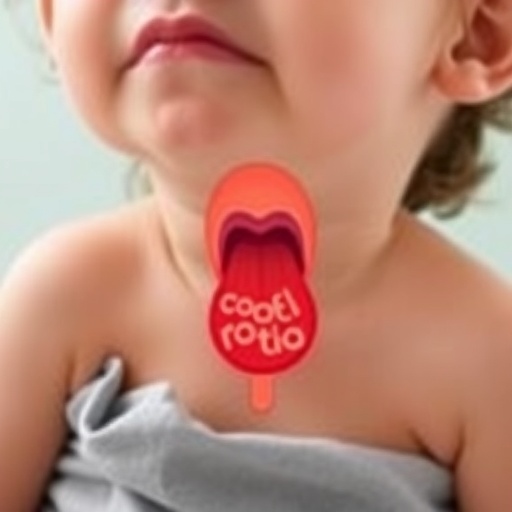A pioneering study spearheaded by researchers at National Jewish Health has unveiled compelling evidence pointing to the skin as an innovative, non-invasive biomarker for eosinophilic esophagitis (EoE), a chronic allergic condition affecting the esophagus in children. Traditionally diagnosed through invasive endoscopic procedures, EoE’s elusive nature has challenged clinicians, particularly in pediatric patients who lack overt skin symptoms. This groundbreaking research opens a promising avenue by employing skin tape stripping, an accessible technique that could radically transform diagnosis and monitoring of this debilitating disease.
The investigative team, including Elena Goleva, PhD, and Donald Y. Leung, MD, PhD, working in concert with Seema Aceves, MD, PhD of the University of California San Diego, centered their exploration on ceramides—specialized lipid molecules integral to skin barrier integrity and function. Ceramides are pivotal in maintaining the epidermal barrier, regulating hydration, and protecting against environmental insults. Disruptions in ceramide synthesis have been extensively linked to skin disorders such as atopic dermatitis, yet their involvement in esophageal allergic conditions was hitherto underappreciated.
Published in the prestigious Journal of Allergy and Clinical Immunology, the study meticulously demonstrated that children suffering from EoE, even those without clinical signs of eczema or other skin diseases, exhibit pronounced deficiencies in long-chain and ultralong-chain ceramides in their skin. These lipid abnormalities suggest a systemic epithelial barrier dysfunction that transcends the traditional compartmentalized understanding of allergic diseases localized to either skin or esophagus.
Eosinophilic esophagitis is an immune-mediated inflammatory disorder characterized by an eosinophil-predominant infiltration of the esophageal mucosa, leading to tissue remodeling and symptomatic esophageal dysfunction. The disease is often comorbid with atopic conditions such as asthma, food allergies, and particularly atopic dermatitis. Despite this connection, no reliable surrogate markers have existed, complicating early diagnosis and disease monitoring without resorting to invasive endoscopy.
Dr. Goleva emphasized the significance of these findings, asserting that “our research provides the first evidence that skin barrier lipid abnormalities exist in EoE independently of visible skin disease.” This suggests a unified epithelial barrier hypothesis wherein disrupted lipid metabolism may govern susceptibility and pathogenesis across allergic tissues. Such a paradigm challenges previous concepts and invites a broader investigation of cutaneous and mucosal immune interactions.
The methodology employed in this study exemplifies cutting-edge lipidomics. Utilizing liquid chromatography coupled with tandem mass spectrometry (LC-MS/MS), the team conducted a comprehensive analysis of ceramide species extracted from skin samples collected via tape strips applied to participants’ forearms. This highly sensitive and specific approach allowed for the nuanced identification and quantification of ceramide molecular species, shedding light on subtle yet meaningful lipidomic shifts linked to EoE.
By highlighting the shared dysregulation of ceramide synthesis in the skin of EoE patients, the research advances the hypothesis that epithelial barrier defects may constitute a foundational element in diverse allergic diseases. The presence of similar lipid abnormalities in both atopic dermatitis and EoE suggests that therapeutic interventions targeting lipid metabolism might hold promise for multi-organ allergic conditions, potentially revolutionizing disease management strategies.
This novel skin tape stripping technique, by circumventing the necessity for invasive endoscopic procedures, holds the potential to streamline patient care. Dr. Leung noted that “if validated in larger cohorts, this simple and non-invasive skin test could transform clinical practice by allowing early detection and monitoring of eosinophilic esophagitis through skin lipid profiling.” Such innovation promises to reduce patient burden and healthcare costs substantially.
Importantly, this research underscores the systemic nature of allergic conditions and strengthens the case for a holistic approach to allergic disease research. The identification of epithelial vulnerability via skin biomarkers implies that early intervention could preempt the onset or exacerbation of esophageal pathology, improving long-term outcomes for pediatric patients.
Furthermore, the parallels drawn between skin and esophageal barrier impairments open intriguing questions regarding shared genetic and environmental factors influencing ceramide metabolism. Future studies could explore how dietary components, microbiome alterations, and epigenetic modifications interact to modulate epithelial lipid homeostasis and susceptibility to allergic inflammation.
As this research continues to evolve, the integration of lipidomic profiling into routine clinical workflows could foster personalized medicine approaches for allergic diseases. By defining precise molecular profiles of barrier dysfunction, clinicians might tailor interventions such as ceramide supplementation or novel lipid-targeted therapies to individual patient needs.
Overall, the findings by the National Jewish Health team illuminate a transformative path forward in understanding and managing eosinophilic esophagitis. By bridging dermatology and gastroenterology through lipid metabolism, this study reshapes the landscape of allergic disease diagnosis and offers hope for less invasive, more effective diagnostic tools to ultimately improve pediatric patient care worldwide.
Subject of Research: Eosinophilic esophagitis and skin barrier lipid abnormalities in pediatric patients
Article Title: Cutaneous ceramide synthesis is dysregulated in pediatric eosinophilic esophagitis
News Publication Date: 5-Jun-2025
Web References:
- https://www.nationaljewish.org/doctors-departments/elena-goleva
- https://www.nationaljewish.org/doctors-departments/donald-y-m-leung
- https://www.jacionline.org/article/S0091-6749(25)00220-9/fulltext
Keywords: Atopic dermatitis, eosinophilic esophagitis, ceramides, skin barrier, lipidomics, epithelial barrier dysfunction, pediatric allergy, non-invasive diagnostics




